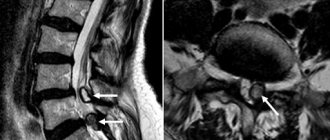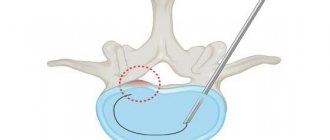September 24, 2019
30046
0
3.4 out of 5
Radiofrequency ablation of the spine (RFA) is a modern, safe, selective, minimally invasive treatment method widely used in spinal surgery to eliminate severe pain. It provides a long-lasting effect, which is due to blocking signal transmission from the site of origin of the nerve impulse to the central nervous system.
The RFA procedure for the spine is performed at the SL Clinic. Our modern equipment and the high level of professionalism of our surgeons allow us to perform minimally invasive interventions with extreme precision, which reduces the risk of complications to almost 0 and allows us to give good prognoses.
Radiofrequency ablation device
RFA: what is it
The radiofrequency ablation technique was first tested in 1980. Since then, it has been constantly improved and replaced other methods of treating pain. Today, RFA is one of the most popular minimally invasive procedures, mainly due to the high precision of the surgeon’s actions and the controllability of each manipulation.
Needles installed in the joints of the spine
Its essence is to insert a conductor needle 100–150 mm long under the control of an image intensifier to the facet nerve on the side of the damaged joint and insert an electrode connected to the generator through it. It has a working bare end with a cut of 5–10 mm. The radio frequency generator ensures the maintenance of the required voltage level in the created electrical circuit and is connected to two electrodes: active (damaging) and indifferent (scattered).
Heat generation is observed only directly around the uninsulated end of the damaging electrode as a result of the passage of electric current through it. In this case, the intensity of tissue heating is determined by its electrical resistance.
The medial nerve of the facet joint that receives radiofrequency treatment
Therefore, ablation of nerves of different nature requires exposure to currents of different frequencies. The approach of the needle to the nerve at the optimal distance can be felt by the appearance of a buzzing or tingling sensation while maintaining the voltage at values up to 0.5 V.
RFA is performed under local anesthesia, which allows the patient to remain conscious during the procedure and independently control the situation. At SL Clinic, radiofrequency ablation of the spine, the cost of which is given below, is performed by some of the best spinal surgeons in the capital and region.
Types of RFA
It can be performed in two modes:
- Continuous - heat constantly entering the tissue surrounding the active part of the electrode leads to cauterization of nerve tissue fibers in this area, 0.7 cm in size. Coagulation is most active in the area located in close proximity to the electrode. As you move away from it, a decrease in its intensity is observed. Studies have shown that it is most effective to place the tip parallel to the nerve and, if necessary, multiple exposures should be made to treat the entire affected area. In this mode, the duration of exposure reaches 1–1.5 minutes, and the tissues are heated to 70–90 °C.
- Pulsed currents - the method involves the use of an electric field created by alternating current. The RFA procedure of the spine involves alternating short-term current bursts of 20 ms with pauses of 480 ms. The severity of the therapeutic effect does not depend on heat. In this case, the created temperature does not exceed 42 °C, which does not provoke thermal destruction. This allows it to be used for treating spinal ganglia with radiculopathy and in other cases when the use of high temperatures is contraindicated.
Diagram of needle installation
After completion of the procedure, a certain volume of a mixture of local anesthetics and hydrocortisone is injected into the treatment site. Only after this the guide needle is removed.
Manipulation is carried out with each damaged joint that causes pain. RFA allows you to relieve pain, but without making adjustments to your lifestyle, there remains a high risk of relapse, but with the localization of the lesion elsewhere.
Image intensifier - X-ray installation under which RFA is performed
How to carry out the procedure
Radiofrequency denervation of the spine is performed with local anesthesia and monitored by interoperative X-ray. Facet rhizotomy involves the passage of high-frequency currents through the body tissues to the nerve endings and their destruction. A prerequisite for success is to ensure complete immobility of the patient in order to insert the electrodes as accurately as possible.
- A puncture is made in the nerve tissue and needles are inserted, at the ends of which small electrodes are installed through which a current passes.
- Overcoming tissue resistance, the temperature of the plates rises.
- The result of exposure is cauterization of the nerve.
- During exposure, slight painful sensations may occur.
- The whole procedure takes no more than 40 minutes.
Advantages of using RFD of the spine:
- high efficiency with minimal time costs;
- fast recovery;
- improving quality of life;
- local anesthesia is sufficient;
- the impact is only on a small area that is well controlled;
- the procedure is non-traumatic, well tolerated, and there is virtually no risk of side effects;
- It is possible to repeat RFD.
Indications for radiofrequency ablation
RFA is successfully performed when:
- facet syndrome;
- radiculopathy;
- neuropathic pain;
- dysfunction of the sacroiliac joint.
- trigeminal neuralgia
- intercostal neuralgia
- neuralgia of the greater occipital nerve
- coccydynia
- pain in the neck
- pain in the thoracic spine
- lower back pain
RFA is often used for facet syndrome when conservative therapy does not produce the desired results. The disease is accompanied by deep, aching pain in the lower back, often radiating to the legs, buttocks, groin, and morning stiffness.
Needles installed in the joints of the vertebrae.
It is believed that radiofrequency ablation of the facet joints of the lumbar spine will be effective if a properly performed block with anesthetic provides significant pain relief.
The method has also proven itself well in the treatment of radicular pain if, with transforaminal administration of the anesthetic, a pronounced decrease in the intensity of pain is observed.
Often the cause of pain is damage to the joint capsule. C5-C6 are considered to be the most susceptible to such injuries. Damage to the facet joints of the neck provokes headaches and significant discomfort in the area of the shoulder blades and trapezius muscles. In such cases, radiofrequency ablation of the facet joints of the cervical spine is also very effective.
RFA of the lumbar spine has proven itself to be excellent for pathologies of the sacrolumbar joint. It is disorders in this segment that lead to pain in 10–35% of patients.
Needles installed in facet joints.
In any case, for the procedure to be highly likely to give good results, several conditions must be met:
- persistence of neck pain for more than 2 months;
- lack of positive results after conservative therapy;
- improvement of the condition after the blockade.
Recovery period
The recovery period after the intervention usually lasts about an hour. You will be allowed to go home when you feel in a cheerful state, your blood pressure and pulse are completely stabilized, and your motor activity is restored - at least to the preoperative extent. Deep insertion of a needle containing an anesthetic may cause temporary muscle weakness or a feeling of numbness in the limbs.
Remember!
For 24 hours after the operation, you are prohibited from driving or operating complex technical devices.
The persistence of the effect of high-frequency facet denervation is limited in time. The nerve endings may grow back, but in general patients experience a long period of remission. At this time, it makes sense to begin physical therapy treatment to strengthen the affected facet joints. In case of relapse, high-frequency destruction may be repeated.
Contraindications and rehabilitation
RFA of the facet nerves of the lumbar spine cannot be performed if:
- local or generalized infection;
- hemorrhagic diathesis;
- pregnancy.
The procedure does not require a long hospital stay. Almost immediately after its completion, patients can walk and return home within 2 hours. During the recovery period, restrictions are imposed mainly only on heavy lifting and active sports. But performing light household work is allowed. During radiofrequency ablation of the lumbar region, it is not recommended to bend over for the first day. Otherwise, patients can lead their usual lifestyle.
Ablation device with needles.
Cost of the operation, where can RFD be performed?
The operation can be performed in traumatology and orthopedics centers. It is provided free of charge in cases where the patient is provided with a quota for high-tech medical treatment. The cost of a paid operation averages 35-50 thousand rubles, and in some clinics reaches 80 thousand rubles.
Radiofrequency denervation is a progressive method for treating spinal diseases, characterized by safety and fairly high efficiency.
With RFD, patients can reduce the intensity of chronic pain or get rid of it completely, which significantly improves quality of life and reduces the need for pain medications. However, it must be borne in mind that this method does not eliminate the cause of the disease, but only helps to cope with its symptoms.
RFA of the lumbar and thoracic spine price
“SL Clinic” invites you for a consultation with a spinal surgeon, traumatologist-orthopedist, who, based on the results of examinations, will be able to accurately determine the need for RFA of the spine and evaluate its potential effectiveness in a particular case. Our price for radiofrequency ablation of the spine makes the procedure for eliminating pain accessible to a wide range of people.
The cost of radiofrequency treatment for back pain is 68,000 rubles and depends on: - The cost of needles for radiofrequency ablation; — Clinics and class wards. The price includes: — Stay at the clinic before and after surgery; — Operation; — Cost of needles for radiofrequency ablation; — Observation and consultation during the rehabilitation period. All clinic services and costs are listed in the price list.
Our vertebrologists are thoroughly familiar with the technique of performing RFA, have at their disposal modern equipment and a whole staff of related specialists who can provide qualified assistance. “SL Clinic” gives you a chance to permanently get rid of pain caused by facet syndrome, damage to the lumbosacral spine and other disorders. With our help, you can almost immediately feel like a new person and return to a full life.
Efficiency of the procedure
The therapeutic effect of the procedure is noticeable immediately, the pain syndrome disappears. The final result can be assessed after one and a half months, since in some cases effectiveness appears only after this period.
The effectiveness of such treatment in various cases can last up to several years. In many cases, the patient needs to engage in physical therapy to restore and develop the joint. If pain relief is not provided, a person will not be able to exercise - the pain will not allow him to move normally. After the procedure, patients begin to exercise, which helps avoid surgery altogether or postpone it for a long time.
If the necessary measures are not taken in a timely manner, pain will become a constant daily test for a person, and there can be no talk of an active lifestyle at all, because even the simplest movements will be difficult.










